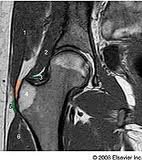The Iliotibial band is made of almost completely unstretchable reticular fibres making this a structure that neither shrinks or elongates. It is like a steel cable on the outside of your thigh that the muscles of the front and back of the thigh take their sideways attachments to. We often have patients who come in having been told that their ITB is too tight. This is both a true and misleading statement. The band does become tight – but does so because the two points of its top and bottom attachment have moved away from each other. This almost always happens because of internal thigh rotation (toward ‘knock knee’ which happens almost always because of foot pronation. It doesn’t become tight because it shrinks. Massage can be very painful and is (in my opinion) of no benefit. We treat ITB pain by limiting this motion of the thigh bone in the hip socket and find that results are generally very good.
When ITB pain occurs, it is usually because the ITB rubs too hard in its elongated position against a bump of bone in the outer buttock called the greater trochanter. There is a small jelly bean sized sack of fluid between the band and the bone called the trochanteric bursa which gets compressed. As the bursa is a self-contained sack of fluid, it has no significant blood supply to take the drug to the pain, which will explain why nearly all anti- inflammatory medications don’t provide relief. Codeine, which acts within the brain rather than at the site of the pain, is the exception and will supply some relief but Codeine generally caused constipation in most people and may be detrimental to the digestive tract in the long term. Topical anti-inflammatory gels etc. cannot penetrate the thick gristle band to reach the inflamed bursa below and generally don’t work at all. Physical methods of reducing inflammation such as heat and ultrasound will help until the area is irritated again by your next day’s walking.
Happily, this condition responds very well to a simple podiatric / foot based treatment. Using custom made plates called orthotics or orthotic devices that go into your shoes, we can control the excessive foot pronation and limit the amount of internal rotation occurring in the leg. This will return the band to the correct orientation and length and stop the excessive pressure on the bursa. This rotation is quite difficult to control, needing a potent and well shaped orthotic and for this reason one-size-fits-all insoles from sport shops or chemists are not suitable. If you are not in Brisbane and unable to see us about your buttock pain, it may be worth suggesting to your podiatrist to incorporate a ‘talonavicular flare’ into your orthotics as this is the factor that we find works best to eliminate pain.
To see this document in downloadable and printable form, please browse to our Iliotibial Band Info Sheet. Alternatively, use this link to return to the Podiatry FAQs Blog.


Recent Comments